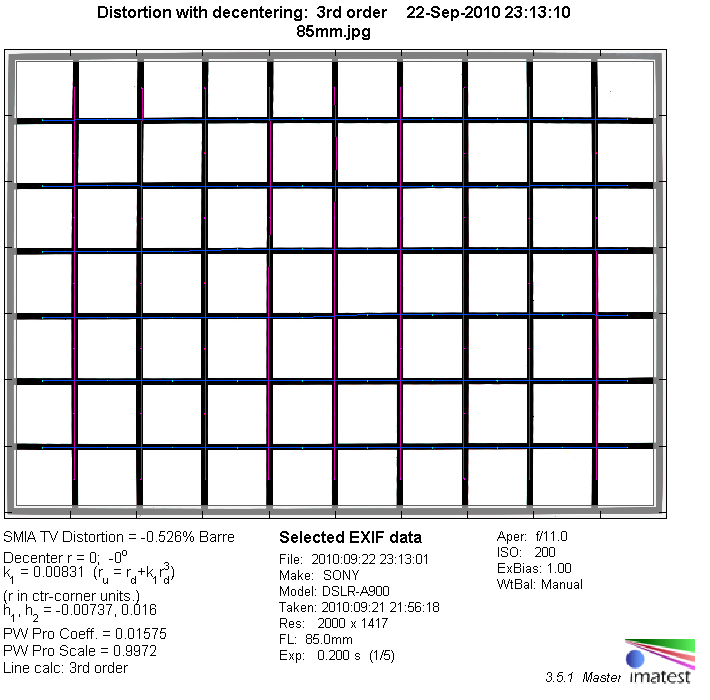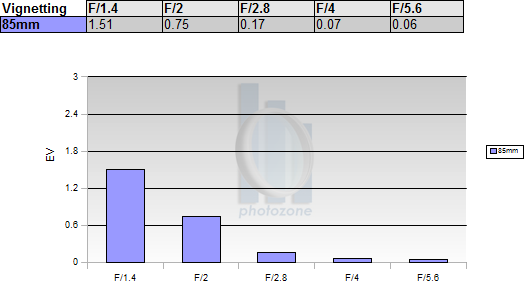|
Zeiss Planar T* 85mm f/1.4 ZA ( Sony SAL-85F14Z ) - Full Format Review / Test Report - Analysis |
|
Lens Reviews -
Sony Alpha (Full Format)
|
|
Page 2 of 3

Distortion
Typical for prime lenses in this range there is virtually no significant distortion to worry about (~0.5%).

The chart above has a real-world size of about 120x80cm.
Vignetting
The amount of light falloff is comparatively moderate within the full format scope.
The vignetting is still clearly visible at f/1.4 and you may still spot a hint of
vignetting at f/2. The issue is absolutely negligible from f/2.8 onwards.

MTF (resolution)
The Zeiss ZA 85mm f/1.4 produced highly impressive resolution figures in the MTF lab.
At f/1.4 the quality is already exceptionally high for such a lens with very good resolution
figures across the image frame. The contrast level is also very snappy here. There's an
additional boost in quality from f/4 onwards and the outstanding quality peak is reached
at f/8. Field curvature is not an issue.
Please note that the MTF results are not directly comparable across the different systems!
Below is a simplified summary of the formal findings. The chart shows line widths per picture height (LW/PH) which can be taken as a measure for sharpness.
If you want to know more about the MTF50 figures you may check out the corresponding Imatest Explanations
Chromatic Aberrations (CAs)
Lateral chromatic aberrations (color shadows at harsh contrast transitions) are generally very well
controlled. You may spot some CAs at f/1.4 at 100% image magnification but this is still no problem
on prints. The issue is pretty much negligible from f/2.8 onwards.

Bokeh
The quality of the bokeh is naturally of major interest for an ultra-large aperture lens and the
Zeiss does not disappoint here. Out-of-focus highlights show a circular shape from f/1.4 up to about
f/2.8. At f/4 the shape deteriorates a little. Typical for such lenses the highlight discs have a
"cat's eye" shape near the borders/corners - this effect dissolves when stopping down.
The highlights show basically no outlining effect - this is about as good as it gets here.
The blur is very smooth and uniform. However, you may also notice the rather massive amount of
longitudinal chromatic aberrations in the cards - more on this in the next chapter.

Longitudinal (Axial) Chromatic Aberrations (LoCA)
LoCAs (non-coinciding focal planes of the various colors), sometimes called "bokeh CAs", can be a problem
in the field. Similar to the Canon 85mm f/1.2 USM L and Nikkor 85mm f/1.4, the Zeiss also suffers from this optical defect. As you can notice below, the halos have different colors - magenta
in front of the focus point and green beyond. The problem is rather pronounced at f/1.4 and
decreases slowly the further you stop down but it is still slightly visible at f/4.
You may also observe that the lens has virtually no focus shift when stopping down - this is often a problem
in this lens class.
|
Move the mouse cursor over the f-stop marks below to observe the respective LoCAs
|
| f/1.4 |
f/2 |
f/2.8 |
f/4 |
|

|
|